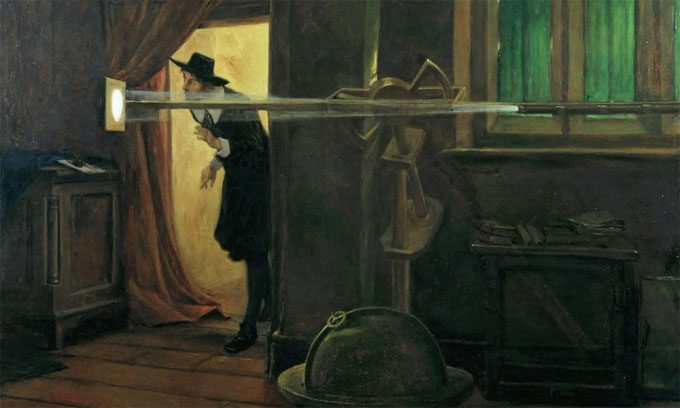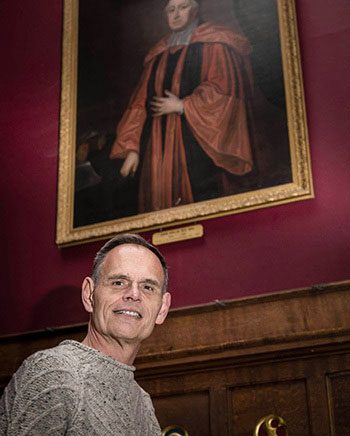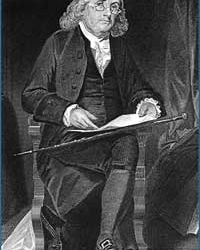Jeremiah Horrocks was an English astronomer, born in 1619 and died in 1641 at the young age of 22. He is recognized as one of the greatest astronomers of the 17th century and was also the author of significant work that laid the foundation for Isaac Newton’s research.
In 1639, on a cloudy afternoon in England, Jeremiah Horrocks became the first person to accurately predict the transit of Venus across the Sun and measured the distance from the Sun to the Earth. His work first demonstrated that the Earth is not the center of the universe but orbits the Sun, debunking the prevailing notions of the time and paving the way for Isaac Newton’s groundbreaking work on gravity.

Jeremiah Horrocks made the first observations of the transit of Venus in 1639. (Image: Eyre Crowe).
However, today, Horrocks is nearly forgotten. Very few people are aware of his significant contributions to the field of astronomy. Horrocks’ work was never published during his lifetime, and he was not widely recognized for his remarkable mathematical achievements.
“Without Horrocks, Newton would not have had the pieces available. Yet he is almost forgotten, except by those who love astronomy,” commented Dr. Matt Bothwell, an astronomer at the University of Cambridge.
A new play titled Horrox, scheduled to be held at the ADC Theatre at the University of Cambridge from March 28 to April 1, 2023, during the Cambridge Festival, aims to reaffirm Horrocks’ rightful place in history. Playwright David Sear describes Horrocks as a genius who changed the way humanity perceives the universe.
The plot of the play begins in 1632 when Horrocks walked to the University of Cambridge. “At the age of 14 or 15 – no one can be sure of the exact number – he walked from Lancashire to Cambridge to study the stars,” Sear shared.
“Before Jeremiah Horrocks, we had no clear understanding of the scale of the universe. He was the first to demonstrate that the Earth is not the center of creation, breaking significant concepts in Christian doctrine,” Sear added.

Playwright David Sear stands before a portrait of John Wallis – the man who helped preserve the works of Jeremiah Horrocks. (Image: Paul Ashley).
Horrocks was born in Lancashire, England, in 1618 and was the son of a clockmaker. Around 1632, he enrolled at Emmanuel College, University of Cambridge, as a sizar – a student receiving financial aid who had to assist with various tasks.
“Horrocks borrowed books from many different colleges within the University of Cambridge. At his age, with such mathematical prowess and the ability to make astonishing observations with rudimentary telescopes and draw conclusions that overturned long-held scientific and religious beliefs about the nature of the universe, he was a genius and 400 years ahead of his time,” Sear remarked.
Horrocks achieved a significant breakthrough in mathematics in 1639 when he was just 20 years old. “He discovered an error in the calculations of the renowned astronomer Johannes Kepler and corrected it,” Sear noted. This correction revealed that the next transit of Venus would occur in just a few days and would not repeat until 1761. “Horrocks was the only one who knew this would happen,” Sear stated.
Horrocks quickly informed his friend, William Crabtree, a cloth merchant and amateur astronomer in Manchester. The two rushed to coordinate and seize the rare opportunity to observe Venus from two different locations, recording crucial measurements that other astronomers missed.
“The only way to measure the distance to the Sun at that time was to accurately understand an object between the Earth and the Sun, and then set up a triangulation to measure,” Sear explained.

A diagram illustrating the transit of Venus in 1639 and 1761 based on Horrocks’s observations. (Image: Science History Images/Alamy)
However, Horrocks’ great work on the transit of Venus was nearly lost forever. Only one handwritten Latin manuscript survived after the Civil War (1642 – 1651) and the Great Fire of London in 1666. This manuscript was passed from one astronomer to another 20 years after Horrocks’ death and was not published until 1662, in an appendix to the work of a Polish astronomer.
“No one understood the importance of the work that Horrocks studied until Newton examined it,” Sear noted.
In 1687, Newton acknowledged the significance of Horrocks’ observations in his book “Principia.” “Newton would not have been able to complete his work on gravity without Horrocks having made these observations beforehand,” Sear commented.
Sear believes the main reason Horrocks did not receive the recognition he deserved was that he died too young. He passed away suddenly in January 1641 under unclear circumstances, at around 22 years old. This prevented Horrocks from publishing his research and gaining acknowledgment from other astronomers, thus he was not celebrated for his discoveries like Kepler or Galileo.





















































